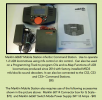I spent about 4 hours today fiddling with CV programming on my LGB 22040 Ge 4/4 I which has the newest MLGB factory installed sound decoder. These are the steps I took. I had been running this loco using the mfx protocol with a Märklin CS3 central station.
1. I added a new DCC loco with address 3 and 29 functions, which is the most allowed for a DCC loco on the CS3, to the CS3 roster. Address 3 is the DCC default for the 22040 loco.
2. I turned off the mfx protocol on the CS3.
3. I operated the 22040 using DCC address 3 with the CS3. This included a check of functions. All worked as expected.
All the above were done using the normal track output of the CS3. Presumably this prepared the decoder to expect DCC operation and programming.
4. I then set up my Massoth PC module by opening up a "new" decoder. I selected the emotion XLS >v3.5 template just to have something to work with.
5. With the loco on the Massoth programming track, I opened the interface which powered the programming track.
6. All the subsequent CV read and writes were done using the single CV option beginning with a read of CV29. The correct value 6 was returned.
7. I wrote the values 17 and 0 into CVs 31 and 32 to enable "Mapping assignment" as per the decoder "
Additional Information... " manual.
8. I read CV 257 which returned the value 54 indicating 54 of the 80 function mapping lines were occupied.
9. next I wrote 53 into CV33, then read CVs 34, 35, and 36 just to see what line 53 had for "Activator", "Stipulations", and "Output". These came back as "F20" button (20), "without level" (64), and the logical operator "and 1" (162). I've no clue what "without level" or the "and 1" logical operator do in this context. (For info the "F20" button turns off the normally on rear lights relative to the direction of loco travel.)
10. I then tried adding a simple function to one the of the locos unused function buttons, "F24".
11. I wrote the values 24 ("F24" button) into CV 34, 0 (no stipulation) into CV35, 177 (sound1, the horn) into CV36 then 55 into CV37 which wrote the settings into previously unoccupied function mapping line 55.
12. I then closed the Massoth PC Module interface to the programming track and reconnected the track with loco to my CS3 (still set for DCC protocol only).
13. I checked operation of the loco. Everything seemed OK and indeed the previously unused "F24" button now triggered the horn.
So far all seems as expected from the scant information available in the Märklin manuals included with the loco.
I then tried to undo what I'd just programmed into function mapping line 55 using the Massoth PC Programming Module. All I accomplished was to cause the horn to sound when the lights were turned on

! I realize now that I only succeeded in changing the "Activator" for function mapping line 55 I had created to the "F0" (light)button. There are no clear,
at least to me, instructions on how to delete a function mapping line with DCC programming. There is no way to insert null values into CVs or otherwise void the line.
I was able to fix what I had done using my CS3 and the mfx protocol Loco Edit pages. I edited the "Light" button's action by deleting the horn which now showed up in the previously empty "Sound" field of the button's configuration.
I looked at the loco CVs I had changed once more using the Massoth PC module. The CS3 did seem to have put the CVs be back to what they were when I first began.
I then looked at what was in first four function mapping lines to see if I could make heads or tails of what was happening with the "Activators", "Stipulations", and "Outputs". The only one that made sense to me was the fourth line I looked at. It was a simple, straight forward mapping similar to the line 55 I had added above - the "F2" button turns "brake squealing off".
What I learned from this exercise -
First and foremost a lot more information needs to be made available by Märklin in order to effectively access the extensive capabilities of these latest MLGB sound decoders. At least in the english language. Maybe it is out there in German. There are no instructions or examples of what the logical operators "and 1" through "and 16", "or 1" through "or 8", and "Xor 1" through "Xor 4" do in the decoder's function mapping environment. Likewise, there is no explanation of what the Flip Flops 1 through 4 do. There is no clear method to delete a line from the 80 available once it is created.
Secondly, I would highly recommend using the Märklin Programming Tool, a Märklin CS3, or waiting until JMRI has a decoder template for the latest MLGB sound decoder if you want to do any modifications to the decoder function mapping.



